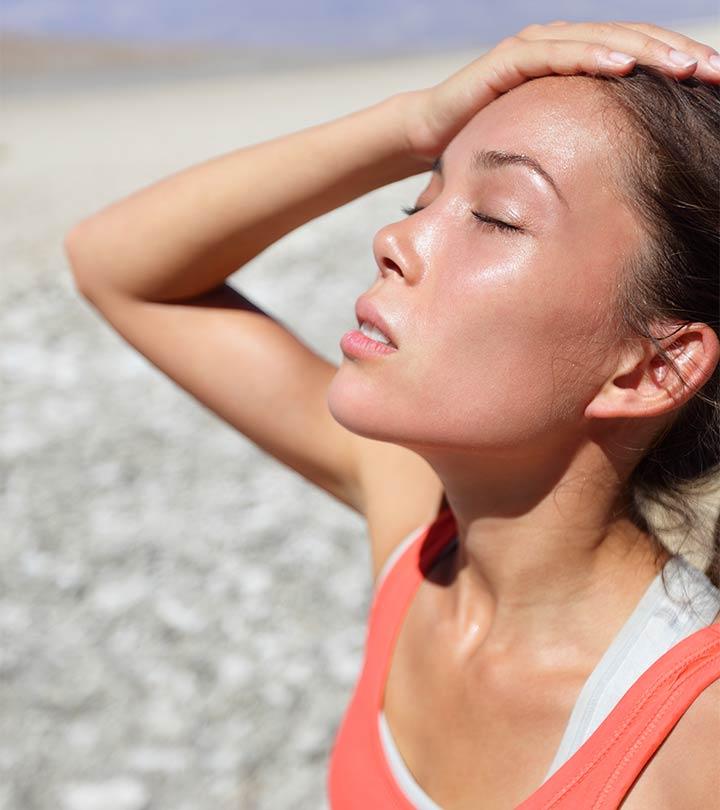7 Home Remedies To Treat Fordyce Spots (White Spots On Lips)
Eliminate these tiny, odd, pimple-like lumps with natural ingredients!

Image: ShutterStock
Fordyce dots are yellowish-white spots that can appear on the lips and are opaque to semi-transparent due to enlarged oil glands without hair follicles. Dr. Paola De Mozzi, MRCP, Consultant Dermatologist at Royal Free London NHS Foundation Trust, says, “Fordyce spots are harmless benign spots. They are nothing concerning or cancerous.” They can be present as lumps or patches around the lip line. While these are entirely safe and non-harmful, people often use home remedies to treat Fordyce spots for cosmetic reasons.
Fordyce spots appear on the lips of people of all ages and genders. They can, however, also show up on the genitals. Continue reading to learn more about this condition and how you can apply home remedies to get rid of them.
In This Article
What Causes White Spots On The Lips?
Fordyce spots are caused by the abnormal secretion of sebum (oil) by the sebaceous glands present in the skin
(1). The accumulated sebum acts as a breeding ground for bacteria, and this infection causes inflammation of the surrounding tissue. It is important to note that this is not a sexually transmitted infection.
Dr. Mozzi says, “It looks like a tiny white or yellow bump under the skin (typical size is between 1 to 3 mm in diameter). Fordyce spots (also called Fordyce’s granules) are often multiple or clustered together.” She adds, “They are enlarged oil glands (sebaceous glands) that are not associated with hair follicles, found around the edges of the lips and occasionally on the genital skin such as the scrotum, shaft of the penis, or on labia.”
There are several home remedies that may help treat Fordyce spots on the lips. But before treating them at home, you must consult a specialist to eliminate the chance of these spots being a sign of a sexually transmitted disease. This is just to make sure that the white spots on your lips are indeed Fordyce spots.
How To Spot These Spots!
Fordyce spots measure 1-3 mm. They are usually whitish-yellow. They are mostly formed outside or on your lips.
Stretch the skin to see the spots clearly. Do not confuse Fordyce spots with whiteheads, epidermoid cystsi Small, non-cancerous, and slow-growing lumps beneath the skin that occur due to a blocked hair follicle. , and basal cell carcinomai The most common and frequently occurring type of skin cancer that develops most often on areas of skin exposed to the sun. .
How To Get Rid Of White Spots On Lips
If the white spots on the lips are recognized as Fordyce spots, you can use home remedies made of herbs, oils, and other easily available Ayurvedic ingredients as well. We have mentioned a few simple remedies below for you to help manage this condition.
1. Garlic
Garlic has anti-inflammatory, antibacterial, and antimicrobial properties (2),(3),(4).
A 2021 study published in the Archives of Microbiology journal demonstrated garlic’s antibacterial activity against several drug-sensitive and multidrug-resistant bacterial strains. It compared the action of garlic extract with gentamycin, a standard antibiotic issued to fight off Enterococcus faecalis, methicillin-susceptible Staphylococcus aureus, Pseudomonas aeruginosa, and Escherichia coli, along with their multidrug-resistant strains.
Fresh garlic extract showed the highest inhibitory activity against S. aureus, while the lowest was against P. aeruginosa. Thus, garlic is an effective natural bactericidal agent that may help manage Fordyce spots.
Antimicrobial Activity Of Garlic Extract Against Bacterial Strains
Source: Antibacterial properties of Allium sativum L. against the most emerging multidrug-resistant bacteria and its synergy with antibioticsIt contains active compounds like ajoene and allicin that help eradicate bacteria in your bloodstream. Thus, increasing the consumption of garlic can help kill breeding bacteria and maintain oral hygiene.
You Will Need
- 2 garlic cloves
- 200 mL of water
- 1-2 tablespoons of lemon juice (optional)
What You Have To Do
- Crush the garlic cloves and blend with water.
- Add lemon juice for flavor.
- Drink this before or after your meals.
How Often You Should Do This
Have 2-3 glasses in a day.
 Quick Tip
Quick Tip2. Apple Cider Vinegar
Apple cider vinegar acts as an astringenti A substance or chemical agent that helps shrink tissues and dry up skin secretions to tighten pores and cleanse the skin. and has antibacterial properties that help eliminate bacteria (5), (6). It contains a group of fatty acids that inhibit the growth of bacteria and bring about balance in the sebum secretions.
You Will Need
- A few drops of apple cider vinegar
- A few drops of water
- Cotton swab
What You Have To Do
- Mix equal quantities of ACV and water.
- Apply this solution to the affected area with a cotton swab.
- Rinse with lukewarm water after a few minutes.
- You can also add a tablespoon of ACV to a glass of cool water and drink this twice a day.
How Often You Should Do This
Do this no more than twice a week.
Caution: If you experience any burning sensation or irritation, rinse it off immediately and apply an ice cube on the area for a minute or two.
3. Coconut Oil
Most often, the excess secretion of sebum that causes white spots is due to dehydrated and dry skin. Coconut oil moisturizes your skin and makes it healthy and smooth (7). It also possesses anti-inflammatory and antimicrobial properties (8), (9). The essential oil of lavender used in this remedy will soothe skin inflammation (10). However, there is no direct scientific evidence to prove the efficacy of coconut oil in treating Fordyce spots.
You Will Need
- 2-3 tablespoons of coconut oil
- A few drops of lavender essential oil
What You Have To Do
- Add the essential oil to the coconut oil and mix well.
- Using clean fingers, apply this oil to the affected area, and let it sit for a couple of hours.
- You can store the remaining oil mix in a small container.
How Often You Should Do This
Reapply 2 times a day.
4. Jojoba Oil And Argan Oil
Jojoba oil is rich in vitamin E and helps control excess sebum production (11). Argan oil is traditionally used to treat skin infections, and it also moisturizes the skin and increases its elasticity (12), (13).
You Will Need
- 1-2 drops of argan oil
- 1-2 drops of jojoba oil
What You Have To Do
- Mix the oils and apply the blend all over your lips with a clean finger.
- Let the oil stay for 8-10 minutes.
- Rinse with water.
How Often You Should Do This
Apply this 2-3 times a day.
5. Essential Oils
Benzoin oil relieves dryness and soreness of the lips (14). Tea tree oil is a wide-spectrum antimicrobial agent that can kill any microbes that may have settled in the white spots (15). While these oils relieve symptoms and sterilize the area, cabreuva oil promotes healing and prevents the formation of scar tissue (14).
You Will Need
- 2-3 drops of benzoin oil
- 2-3 drops of tea tree oil
- 2-3 drop of cabreuva oil
- 1 tablespoon of olive oil
- 1 tablespoon of Scotch pine essential oil
What You Have To Do
- Blend all the oils.
- Apply this mixture on the white spots on your lips. Allow it to dry for a couple of minutes.
- Clean with lukewarm water and a gentle antibacterial cleansing soap.
How Often You Should Do This
Repeat 1-2 times daily.
Caution: Skip the benzoin oil from the mix if you have sensitive or irritable skin. Also, if you have not previously used any of the essential oils mentioned, please do a patch test before using them as a remedy for white spots on the lips.
6. Buttermilk
Buttermilk soothes the inflammation and irritation caused by the Fordyce spots on your lips. However, there are no scientific studies to prove its effectiveness in treating these spots.
You Will Need
- Buttermilk
- Cotton ball
What You Have To Do
- Dip the cotton ball in the buttermilk and apply it to the lips.
- Let it dry naturally. Rinse with water.
How Often You Should Do This
You can repeat this a few times during the day.
 Quick Tip
Quick Tip7. Aloe Vera
Aloe vera is renowned for its soothing, wound healing, antimicrobial, and antifungal properties. It can also help alleviate inflammation (16). However, there is a lack of scientific studies to conclusively prove its effectiveness in treating Fordyce spots.
You Will Need
- Aloe vera gel or fresh aloe vera leaf
What You Have To Do
- Extract fresh aloe vera gel from a leaf or use store-bought aloe vera gel.
- Apply a small amount of the gel directly to the affected area on the lips.
- Allow it to air-dry naturally.
How Often You Should Do This
You can repeat this process several times throughout the day as needed.
You can use any of the above-mentioned home remedies to treat white spots on the lips. Make sure you are not allergic to any of the ingredients before using them. After going through our section on how to get rid of fordyce spots, here are a few other tips you can follow to treat this ailment quickly.
Prevention Tips
According to Dr. Mozzi, “It is not recommended to squeeze Fordyce spots as this may cause infection and scarring. Fordyce spots are best left alone.”
Here are some tips you can follow:
- Drink juices from sour fruits like lemon, orange, etc. This may help reduce the spots due to the vitamin C.
- If you notice white spots on the lips, quit applying chemical products like lotions and creams instantly to make sure the issue does not worsen.
- Do not allow your lips to become dry and dehydrated. Also, the microorganisms in the mouth may further intensify the issue. Hence, avoid licking your lips.
- Use scrubs like sugar granules on the lips once or twice a week. This will reduce the appearance of the white spots by eliminating the upper dead cells of the lips. Scrub your lips gently because the epidermisi The outermost and thinnest layer of skin that protects the body from UV rays, moisture loss, and harm. on the lips is incredibly sensitive.
- Consuming folic acid supplements with your food can help reduce the appearance of white patches on the lips. You can obtain folic acid products from any pharmacy. Consume them regularly to reduce the spots on the lips faster. Make sure you consult your doctor and learn about alternatives if needed.
- Incorporating vitamins A, D, B complex, C, K, and E into your regular diet can help accelerate the elimination of Fordyce spots on the lips. You can consume green leafy vegetables, yogurt, and lentils.
- These spots are not due to poor oral hygiene. You may develop Fordyce spots even though you follow good oral hygiene practices. However, it is essential to be cautious as soon as you notice these spots. Always keep your mouth clean.
This article lists some simple home remedies for dealing with white spots on the lips. Most of the remedies discussed above are not harmful, but their efficacy needs to be established through research.
You can also opt for permanent treatments to get rid of white spots on the lips (other than Fordyce spots). These treatments include vaporizing laser therapy and chemical peels. However, you need to consult a professional before opting for these treatments.
Infographic: 4 Quick Home Remedies For Fordyce Spots
The over-secretion of sebum can form a breeding ground for bacteria and cause inflammation, leading to Fordyce spots. The good news is that a few ingredients from your kitchen can help get rid of these spots. We have rounded up 4 home remedies that can help you treat Fordyce spots quickly. Check out the infographic below to know more! Illustration: StyleCraze Design Team
Fordyce spots or yellowish-white spots on the lips appear due to excessive sebum production and subsequent infection that results in the inflammation of tissues around the area of the lips. While they are benign and painless, individuals prefer to get rid of them due to cosmetic reasons. However, before you apply any of the home remedies to treat Fordyce spots, you need to correctly identify and distinguish them from cysts, whiteheads, and basal cell carcinoma. Once you are certain that what you have are Fordyce spots, you may choose from common, traditional ingredients like garlic, coconut oil, essential oils, and buttermilk to get rid of them. You also need to make certain lifestyle changes and take a holistic approach to manage the recurrence of these spots.
Frequently Asked Questions
Can stress cause Fordyce spots?
Dr. Mozzi opines, “No. Stress is not a known cause of Fordyce spots.”
Do Fordyce spots go away on their own?
Fordyce spots usually do not go away on their own, but as they are benign, no medical treatment is needed. Individuals who wish to get rid of them for cosmetic purposes can opt for home remedies or dermatological procedures.
Do Fordyce spots get bigger?
Fordyce spots are formed when sebaceous glands become enlarged, but the spots themselves do not grow beyond a specified measurement of 1-3 mm.
Key Takeaways
- Massaging some coconut oil on the affected area is an effective way to moisturise the skin and treat white spots on the lips.
- Use buttermilk to reduce the inflammation and irritation caused by Fordyce spots on your lips.
- Drink juices from sour fruits rich in vitamin C as they may help reduce the spots.
- Add foods rich in vitamins A, D, C, K, and E to your regular diet to support the elimination of Fordyce spots on the lips.
_illustration.jpg.webp)
Image: Stable Diffusion/StyleCraze Design Team
References
Articles on StyleCraze are backed by verified information from peer-reviewed and academic research papers, reputed organizations, research institutions, and medical associations to ensure accuracy and relevance. Read our editorial policy to learn more.
- Monteil, R A. “Les grains de Fordyce : maladie, hétérotopie ou adénome? Etude histologique et ultrastructurale” [Fordyce’s spots: disease, heterotopia or adenoma? Histological and ultrastructural study]. Journal de biologie buccale vol. 9,2 (1981): 109-28.
https://pubmed.ncbi.nlm.nih.gov/6943138 - Bayan, Leyla et al. “Garlic: a review of potential therapeutic effects.” Avicenna journal of phytomedicine vol. 4,1 (2014): 1-14.
https://www.ncbi.nlm.nih.gov/pmc/articles/PMC4103721/ - Naganawa, R et al. “Inhibition of microbial growth by ajoene, a sulfur-containing compound derived from garlic.” Applied and environmental microbiology vol. 62,11 (1996): 4238-42.
https://www.ncbi.nlm.nih.gov/pmc/articles/PMC168248/ - Ankri, S, and D Mirelman. “Antimicrobial properties of allicin from garlic.” Microbes and infection vol. 1,2 (1999): 125-9.
https://pubmed.ncbi.nlm.nih.gov/10594976 - Yagnik, Darshna et al. “Antimicrobial activity of apple cider vinegar against Escherichia coli, Staphylococcus aureus and Candida albicans; downregulating cytokine and microbial protein expression.” Scientific reports vol. 8,1 1732.
https://www.ncbi.nlm.nih.gov/pmc/articles/PMC5788933/ - Lukasik, Jerzy et al. “Reduction of poliovirus 1, bacteriophages, Salmonella montevideo, and Escherichia coli O157:H7 on strawberries by physical and disinfectant washes.” Journal of food protection vol. 66,2 (2003): 188-93.
https://pubmed.ncbi.nlm.nih.gov/12597475 - Agero, Anna Liza C, and Vermén M Verallo-Rowell. “A randomized double-blind controlled trial comparing extra virgin coconut oil with mineral oil as a moisturizer for mild to moderate xerosis.” Dermatitis : contact, atopic, occupational, drug vol. 15,3 (2004): 109-16.
https://pubmed.ncbi.nlm.nih.gov/15724344 - Varma, Sandeep R et al. “In vitro anti-inflammatory and skin protective properties of Virgin coconut oil.” Journal of traditional and complementary medicine vol. 9,1 5-14.
https://www.ncbi.nlm.nih.gov/pmc/articles/PMC6335493/ - Shilling, Michael et al. “Antimicrobial effects of virgin coconut oil and its medium-chain fatty acids on Clostridium difficile.” Journal of medicinal food vol. 16,12 (2013): 1079-85.
https://pubmed.ncbi.nlm.nih.gov/24328700 - Cavanagh, H M A, and J M Wilkinson. “Biological activities of lavender essential oil.” Phytotherapy research : PTR vol. 16,4 (2002): 301-8.
https://pubmed.ncbi.nlm.nih.gov/12112282 - Pazyar, N et al. “Jojoba in dermatology: a succinct review.” Giornale italiano di dermatologia e venereologia : organo ufficiale, Societa italiana di dermatologia e sifilografia vol. 148,6 (2013): 687-91.
https://pubmed.ncbi.nlm.nih.gov/24442052 - Monfalouti, Hanae El et al. “Therapeutic potential of argan oil: a review.” The Journal of pharmacy and pharmacology vol. 62,12 (2010): 1669-75.
https://pubmed.ncbi.nlm.nih.gov/21054392 - Boucetta, Kenza Qiraouani et al. “The effect of dietary and/or cosmetic argan oil on postmenopausal skin elasticity.” Clinical interventions in aging vol. 10 339-49.
https://pubmed.ncbi.nlm.nih.gov/25673976 - Orchard, Ané, and Sandy van Vuuren. “Commercial Essential Oils as Potential Antimicrobials to Treat Skin Diseases.” Evidence-based complementary and alternative medicine : eCAM vol. 2017 (2017): 4517971.
https://www.ncbi.nlm.nih.gov/pmc/articles/PMC5435909/ - Carson C F et al. “Melaleuca alternifolia (Tea Tree) oil: a review of antimicrobial and other medicinal properties.” Clinical microbiology reviews vol. 191 (2006): 50-62.
https://www.ncbi.nlm.nih.gov/pmc/articles/PMC1360273/ - Feily A Namazi MR. Aloe vera in dermatology: a brief review. G Ital Dermatol Venereol. 2009 Feb;144(1):85-91. PMID: 19218914.
https://pubmed.ncbi.nlm.nih.gov/19218914/
Read full bio of Dr. Schwarzburg
- Dr. Paola De Mozzi, MRCP, is a consultant dermatologist at Royal Free London NHS Foundation Trust. She has expertise in diagnosing and treating eczema, psoriasis, acne, rosacea, melasma, and general dermatology issues. She is also qualified to perform dermatological surgery, such as on standard moles, melanomas, and other skin cancers.
 Dr. Paola De Mozzi, MRCP, is a consultant dermatologist at Royal Free London NHS Foundation Trust. She has expertise in diagnosing and treating eczema, psoriasis, acne, rosacea, melasma, and general dermatology issues. She is also qualified to perform dermatological surgery, such as on standard moles, melanomas, and other skin cancers.
Dr. Paola De Mozzi, MRCP, is a consultant dermatologist at Royal Free London NHS Foundation Trust. She has expertise in diagnosing and treating eczema, psoriasis, acne, rosacea, melasma, and general dermatology issues. She is also qualified to perform dermatological surgery, such as on standard moles, melanomas, and other skin cancers.
Read full bio of Ramona Sinha
Read full bio of Monomita Chakraborty































